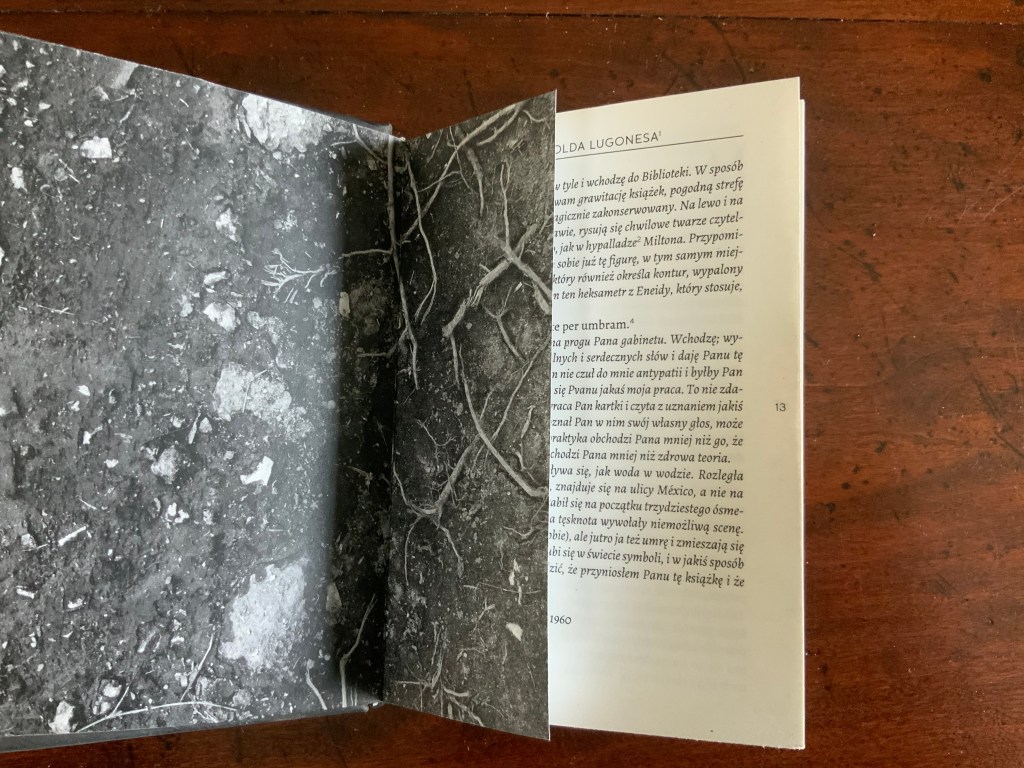Homonim (2015)

Homonim (2015)
Hanna Piotrowska Dyrcz
Charcoal sketches and frottage
Digital print on Woodstock Betulla (uncoated, rough paper) from Adobe Photoshop, Adobe Indesign
16 unnumbered pages including the cover, bound and sewn by hand, H250 x W200 mm
This work’s title appears only as the headword in a definition: “Homonym: words having the same pronunciation but different meanings” (translated here from the Polish). Also the only text in the booklet, it appears flush left vertically on page six as a clue to the less clever Polish-fluent reader/viewer who has not yet attached a word to the image of the tree trunk (bal) and then the same homonymic word to the image of the plank. Having had its visual/verbal fun with those two meanings, the booklet gives the image of a single tree trunk’s cross-section on page seven to set the stage for bal’s third meaning (”ball” as in a dance or masquerade). Over the following pages, the multiple cross-sections gradually turn into a top-down view of whirling dancers who seem to emerge from the bole of the wood.






The artist has filmed the handling of the booklet, but of course, that does not capture the weight and finish of the paper nor the turning back and forward of the pages in the dance on which the words and images lead the reader/viewer. Turning word play into image play in the book form’s sequential and back-and-forth “affordances” makes Homonim a solid conceptual fit in the Books On Books Collection, and the skilful handling of charcoal and its digital transformation provide pleasure with every viewing.
Twórca/The Maker (2016)

Twórca/The Maker (2016)
Text: Jorge Luis Borges
Design, photography, printing and binding: Hanna Piotrowska Dyrcz
Pages: gray recycled paper, digital print. Cover: cardboard, soil and black paint. The book was sewn and bound by hand.
H158 x W113 mm. Unique. Acquired from the artist, 4 February 2020.









El Hacedor (The Maker) is a collection of poems, short stories, essays and literary sketches by Jorge Luis Borges. The way the artist integrates her handling of the book form’s structural challenges with her understanding of Borges’ themes makes this an outstanding artist’s book. Her comments on creating this work are helpful in appreciating it more fully, but they also provide an opportunity to wonder at the creative process. Where does it begin? What leads to what?
Here are her comments in their original order:
One of the challenges was dealing with a large number of footnotes, maintaining the small format at the same time. So I came up with an idea of placing the footnotes not below the main text, but on separate narrow pages, with images on the back side.
The images: The Maker raises questions of evanescence, death, identity, natural changes and the meaning of symbol. I decided to refer to these subjects by finding symbols spontaneously formed by nature and photographing such “hasards objectifs”. All the images in the book are placed either on one or two full pages, which makes the spine set the axis of symmetry. Many of them are hidden between the footnotes’ pages, so that the reader discovers more and more concealed, sometimes disturbing images. Also, the narrow pages with footnotes and images are not included in the page numbering, so that they don’t constitute the book’s usual structure, but rather something that grew/emerged out of the it.
The cover: I wanted the cover more to hide than to inform what’s inside. For this reason, there is no title nor author’s name – just black texture, made from soil painted black. Its gravelly structure is scratchy – I tried to reflect the awkward and surreal character of Borges’ texts, by making the cover visually attractive and intriguing, but at the same time unpleasant to touch.
Borges’ questions may have primed the artist’s photographic eye, but the inventiveness of hiding the images on the reverse of the narrowed footnote pages, of using the cover to echo the images visually and tactilely and of playing with full-page images and narrow-page images and footnotes to hide and reveal the main text comes from thinking about (and feeling) the form of the book, the relationship of image to text, and how the reader’s eyes and hands and mind work and react.
Further Reading
“Lizzie Brewer“. 4 July 2023. Books On Books Collection. For another homage to Borges.
“Sean Kernan“. 23 February 2013. Books On Books Collection. For another homage to Borges.
“Ines von Ketelhodt“. 1 February 2021. Books On Books Collection. For another homage to Borges.
“Peter Malutzki“. Books On Books Collection. For another homage to Borges.
“Aurélie Noury“. 9 November 2020. Books On Books Collection. For another homage to Borges.
“Benjamin Shaykin“. 3 December 2022. Books On Books Collection. For another homage to Borges.
“Rachel Smith“. In progress. Books On Books Collection. For another homage to Borges.
Basile, Jonathan. 2015~. The Library of Babel. Website. Accessed 3 July 2023.
Thank you, Robert, for another dose of the frequent inspiration you send out. Always appreciated. Not remembering the definition of “frottage,” my online dictionary search reveals this homonym, which I couldn’t resist associating with Hanna’s book:
frot·tage (frô-täzh′)
n.
1.
a. The act of rubbing against or touching the body of an unsuspecting person, as in a crowd, to attain sexual gratification.
b. The act of consensual rubbing between two or more people, either clothed or unclothed, to attain sexual gratification.
2.
a. A method of making a design by placing a piece of paper on top of an object and then rubbing over it, as with a pencil or charcoal.
b. A design so made.
[French, from frotter, to rub, from Old French froter.]
. . . and I’m working on a series called Winter Inquiry which has, among other, rubbings made from the same spot on my old mill building onto each piece of paper, placed quasi-consistently, thus a printerly approach to Rub-tage.
LikeLike
P.S., Hanna’s book = conceptually and aesthetically delightful.
LikeLike